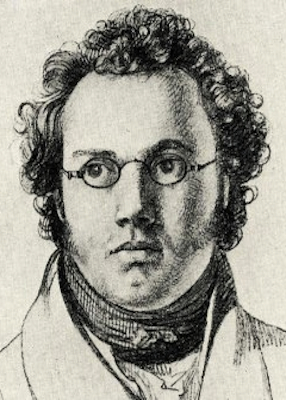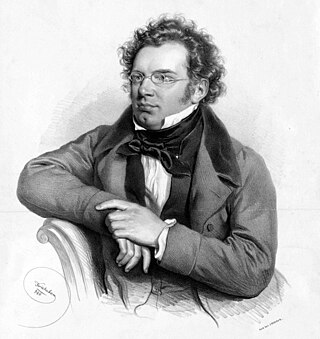Related Research Articles

The Trout Quintet (Forellenquintett) is the popular name for the Piano Quintet in A major, D. 667, by Franz Schubert. The piano quintet was composed in 1819, when he was 22 years old; it was not published, however, until 1829, a year after his death.

The Trio No. 1 in B-flat major for piano, violin, and cello, D. 898, was written by Franz Schubert in 1827. The composer finished the work in 1828, in the last year of his life. It was published in 1836 as Opus 99, eight years after the composer's death. Like the E-flat major trio, it is an unusually large scale work for piano trio, taking around 40 minutes in total to perform.

Franz Schubert wrote his Sonata in C major for piano four-hands, D 812, in June 1824 during his second stay at the Esterházy estate in Zseliz. The extended work, in four movements, has a performance time of around 40 to 45 minutes. It was published as Grand Duo, Op. 140, in 1837, nine years after the composer's death.
The Piano Sonata in A minor D. 845 (Op.42) by Franz Schubert is a sonata for solo piano. Composed in May 1825 and entitled Premiere Grande Sonata, it is the first of three sonatas published during the composer's lifetime, the others being D.850 and D.894. Conceived as a set, these works were composed during what was reportedly a period of relatively good health and spirits for Schubert, and are praised for their quality and ambition. This first sonata in particular marks a significant step toward the composer’s mature piano sonata style; the format and several characteristic stylistic elements continue through the last.
Piano Sonata No. 2, Op. 36, is a piano sonata in B-flat minor composed by Sergei Rachmaninoff in 1913, who revised it in 1931, with the note, "The new version, revised and reduced by author."
The Piano Sonata in A minor, D 537, of Franz Schubert is a sonata for solo piano, composed in March 1817.
Franz Schubert's Piano Sonata in C major, D. 840, nicknamed "Reliquie" upon its first publication in 1861 in the mistaken belief that it had been Schubert's last work, was written in April 1825, whilst the composer was also working on the A minor sonata, D. 845 in tandem. Schubert abandoned the C major sonata, and only the first two movements were fully completed, with the trio section of the third movement also written in full. The minuet section of the third movement is incomplete and contains unusual harmonic changes, which suggests it was there Schubert had become disillusioned and abandoned the movement and later the sonata. The final fourth movement is also incomplete, ending abruptly after 272 measures.

The Piano Sonata in A major D. 664, Op. posth. 120 is a sonata for solo piano composed by Franz Schubert in the summer of 1819.
Franz Schubert's Piano Sonata in A-flat major D 557 was composed in May 1817.
The Piano Sonata in F-sharp minor D 571, was composed by Franz Schubert in July 1817. The sonata was first published long after the composer's death in 1888 by Breitkopf & Härtel.
The Piano Sonata in E major, D 459, is a work for solo piano, composed by Franz Schubert in August 1816. It was first published in 1843, after the composer's death, by Carl August Klemm in Leipzig, in a publication known as Fünf Klavierstücke.

Franz Schubert's last three piano sonatas, D 958, 959 and 960, are his last major compositions for solo piano. They were written during the last months of his life, between the spring and autumn of 1828, but were not published until about ten years after his death, in 1838–39. Like the rest of Schubert's piano sonatas, they were mostly neglected in the 19th century. By the late 20th century, however, public and critical opinion had changed, and these sonatas are now considered among the most important of the composer's mature masterpieces. They are part of the core piano repertoire, appearing regularly on concert programs and recordings.
The Piano Sonata in B major D 575 by Franz Schubert is a sonata for solo piano, posthumously published as Op. 147 and given a dedication to Sigismond Thalberg by its publishers. Schubert composed the sonata in August 1817.
The Piano Sonata in E minor D 566 by Franz Schubert is a sonata for solo piano written in June 1817. The original manuscript appeared to lack a finale. Ludwig Scheibler (1848-1921) was the first to suggest in 1905 that the Rondo in E, D.506 might be that movement. The British composer and musicologist Kathleen Dale produced the first edition using this suggestion in 1948. The 1976 Henle edition by Paul Badura-Skoda followed the same practice.

The Fantasia in F minor by Franz Schubert, D.940, for piano four hands, is one of Schubert's most important works for more than one pianist and one of his most important piano works altogether. He composed it in 1828, the last year of his life. A dedication to his former pupil Caroline Esterházy can only be found in the posthumous first edition, not in Schubert's autograph.
The Piano Sonata in C major, D 279, composed by Franz Schubert in September 1815, has three movements and is regarded as incomplete for lacking a fourth movement. D. 346, an unfinished Allegretto in C major, has been suggested as its final movement.
Brian Newbould is an English composer, conductor and author who has conjecturally completed Franz Schubert's Symphonies D 708A in D major, No. 7 in E major, No. 8 in B minor ("Unfinished"), No. 10 ("Last") in D major, Piano Sonata in C major, D 840, Quartettsatz, D. 703 and String Trio, D. 471. He was educated at Gravesend Grammar School, and earned a BMus degree with top honors from the University of Bristol.

Mass No. 6 in E-flat major, D 950, is a mass composed by Franz Schubert, a few months before his death. It is scored for two tenor soloists, soprano, alto and bass soloists, SATB choir with divisi, 2 oboes, 2 clarinets, 2 bassoons, 2 horns, 2 trumpets, 3 trombones, timpani, violin I and II, viola, cello, and double bass. It was Schubert's final setting of the order of Mass, and is classified as a missa solemnis.
The Piano Sonata in D-flat major D 568, composed in June 1817 by Franz Schubert, is an early version of his Piano Sonata in E-flat major D 568.
Sonatas, duos and fantasies by Franz Schubert include all works for solo piano by Franz Schubert, except separate dances. They also include a number of works for two players: piano four hands, or piano and a string instrument.
References
- Tirimo, Martino. Schubert: The Complete Piano Sonatas. Vienna: Wiener Urtext Edition, 1997.